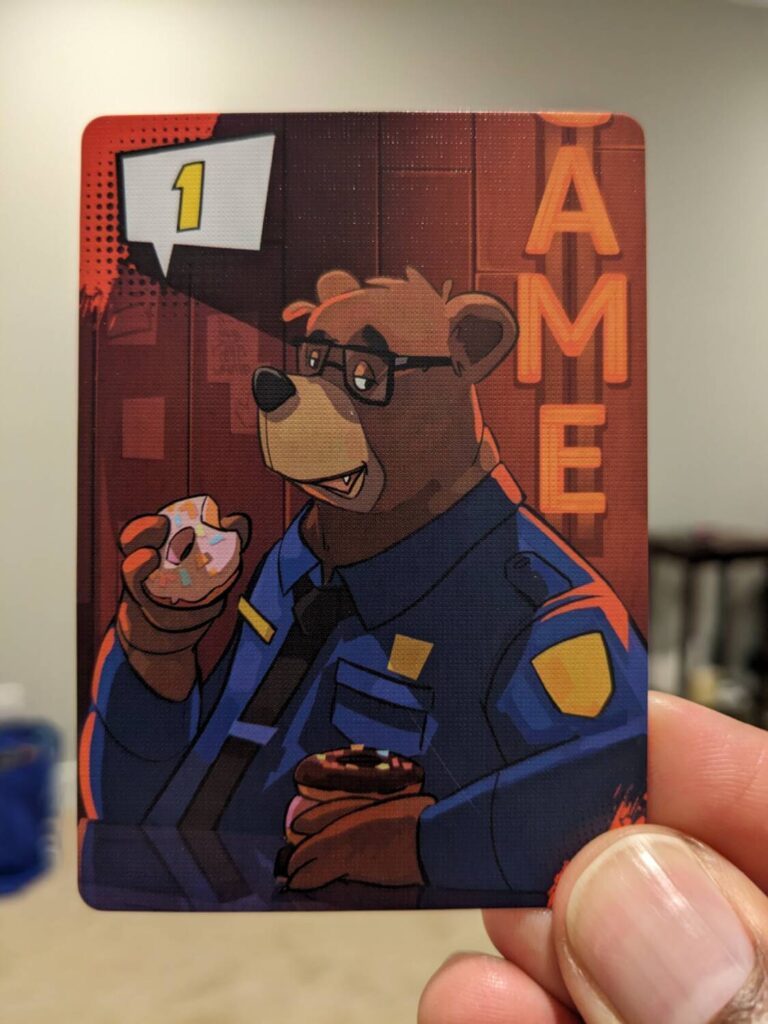“I know I say this a lot nowadays, but there is such a thing as a game that is too short.”
My wife is fantastic for a lot of reasons, but over the last three years, she has been fantastic—not only as a partner, mother and friend. I think she has a bright future as a member of the tabletop media, should she decide to put her mind to it.
This is because my wife is usually the foil for any of my two-player review copies. She also joins any time she can drop in for something short with more players, and she had that chance recently during games of Pan T’es Mort (2023, Matagot).
Pan T’es Mort is a second edition of a game released 10 years ago, designed both then and now by Ludovic Barbe. The game is broken into two halves—a trick-taking phase, then a game of chance. The new version has updated artwork and one additional rule for the back half of the game.

The first half is a simple trick-taker. Each player is dealt four cards, cards that are numbered 1-6. Each of the four turns is very simple: players select one of their hand cards to play simultaneously. On the reveal, whoever has the highest card wins, with one twist: ones beat sixes. Otherwise, cards with the same value cancel each other out, and whoever plays the highest card takes all the other remaining cards face-up in their player area.
The second half of the game is essentially Russian Roulette. A new six-card deck enters play, a deck that has five “Click” cards (Clic in French) and one card that screams “You’re Dead” in French.
The active player takes this deck and has a choice: play the top card of the deck, play one of the cards acquired during the trick-taking phase to reshuffle the entire discard pile before drawing (to increase their odds of drawing a Click), or play a number of trick cards equal to the number of remaining players to skip their turn.
If a player draws the “You’re Dead” card, they are out of the game. If a player sees that there are a few Click cards in the discard pile, they are likely to play one of their trick cards to reshuffle the six-card deck in the hopes that the better odds work out to draw a Click card.
The last person standing wins!

It’s Quick
The best thing about Pan T’es Mort is the wallet-style package. This is a tidy, 30-card wallet game that slides into a pocket with ease. The rules are straightforward, the artwork is cool, and my longest game took less than ten minutes.
Which begs the question: is it too quick?
That’s been a comment which has followed every game; someone is usually surprised at the lack of agency here. The trick-taking phase is sometimes interesting, and sometimes not interesting at all. On my third play of Pan T’es Mort, I was dealt a 5 and three 3s for my four cards. I played my 5 first, in the hopes that someone would save their 6 for a later trick, and I was right, earning me four cards to spend during the second half of the game.
But then I just quickly played my three 3s, assuming that I would lose all of those tricks. (I did.)
In that game, the player with the most trick cards was my wife, so she played first in the second phase. On her first draw with a full deck of Click cards, she had a 5-in-6 chance of not drawing the “You’re Dead” card. Didn’t matter; she was dead on her first turn. Play moved to the player that had the next-highest number of trick cards to start a new roulette phase. That person shuffled the deck of six cards, and promptly murdered herself out of the game on her very first draw.
Down to just two players—me and my daughter. My daughter hadn’t won any tricks in phase one, so I had the first turn. I could have played two cards to skip my turn, but that didn’t seem like a good idea yet…I had a full deck of six cards to run through, so the odds were in my favor.
I drew the top card…and laughed when I saw that I had shot myself dead.
My daughter won, without playing any cards in the second phase and without winning any cards in the first phase. “It feels like I didn’t do anything,” she said afterwards. I had to agree, because she literally didn’t take a turn in the Russian Roulette phase. (The chances of this happening, where three straight players drew the only bad card in a small deck, are obviously low…but, not that low!)
Across my three plays of Pan T’es Mort, a funny thing happened: the player who won no tricks in phase one always ended up winning the game. On the one hand, I love that it might seem the odds are stacked against a player without trick cards to use as protection in phase two, when in reality it’s anyone’s ballgame when phase two begins.
On the other hand, Pan T’es Mort feels like a game where there are really no choices. Sure, it’s a game of chance that lasts ten minutes. But even if you had a chance to draft your trick-taking cards, it would feel like something happened, like I was invested in the outcome. As it is, the game just starts and ends with players hoping that the Russian Roulette phase provides a fun moment or two before one player is left standing.
A couple players have said that they enjoyed Pan T’es Mort most as a game that was not offensive. It shows up and goes on its merry way. I agree, but that makes for a hard recommendation. The trick-taking market is bananas right now; this year alone, I’ve played 20+ trick-takers that I would recommend before Pan T’es Mort.
As a positive, Pan T’es Mort is an easy filler game to use as a game night kickoff, particularly because it accommodates 2-6 players and is so short that it might fit best as the game you play while waiting for your buddy Stu to arrive because Stu is just “a few minutes away.” One of my four-player games of Pan T’es Mort took four minutes. FOUR MINUTES.
Pan T’es Mort is too short. But it is occasionally interesting and has a very fair price point.











Justin and I have a good amount of overlap when it comes to party and group games, though we often have very different experiences of them. We tend to agree on what’s terrible, but we differ on what’s good and what’s great. That’s likely as a result of our sample groups. I played Pan t’es mort as part of a full group of six adults, and we had a lovely time. The first half of the game is harmless enough, but the second half is full of tension and laughter. I’d rate the game at somewhere between a very strong 3 and a weak 3.5. It’s not a masterpiece, but with the right group, it’s a joyous and silly quick little game.
Thanks for the wonderful review. This one is a pass for me. All of my game group, myself included, would truly despise the second half of this game. The randomness — lack of agency, as you put it — would be just too much.
We have had friends in the past try to get us into playing Killer Bunnies. The idea that you could be a master at this game, winning at nearly every aspect of play, and lose the game because someone ended up getting the magic carrot on round two without knowing it? We played once. Never went back. Not a fun experience, even if you win the game.
Another friend picked up a copy of the Golden Ticket game. Same idea — gather up chocolate bars in hopes that yours has the golden ticket inside. You can gather up almost all of them and lose because someone got the right chocolate bar early in the game. We played once. Never went back. Not a fun experience, even if you win the game.
Agency is important. The ability to make meaningful choices in a game is important. If it is all going to come down to a random selection — even a weighted one — nothing from the first part of the game holds any real value.
I think that I, and most everyone in my group, would much rather just play something else.
I mean, anything else.